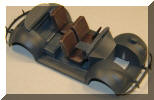The Interior
Assembling the Beetle’s interior essentially involved building upon the
work that was done on the suspension and floor pan. As the lion’s share
of Eduard’s photo etch set was used in the portion of the kit construction
of this phase proved time consuming. It was here that many of CMK’s
details were replaced by thinner gauge metal. Some of the highlights
included super detailing the clutch, brake, and accelerator pedals;
installing the vehicle’s folding map table; and improving the dashboard’s
instrument cluster. I could not find any reference that indicated the
Type 87 featured two vertical rifle racks behind the driver’s seat, though
the Type 92 SS did; however, Eduard’s photo etch set includes them, so I
added them.

Unfortunately, Eduard did not go far enough on detailing the vehicle’s
transmission hump. While the set does include an access plate, there are
no pieces for the relocated emergency brake or the four-wheel drive
lever. These I added from plastic stock based on images found in the
Schiffer book. Lastly, I added Grandt Line wing nuts to the front seat
runners replicating the mounting points found on the real Volkswagens.
Once
the interior was completely assembled and painted I added a variety of
different items from Tamiya, Historex, Verlinden, DML, and Warriors.
These included a large water can and jug, individual canteens and mess
tins, several maps, kit bags, and DAK helmets – both the standard “steel
pot” and the tropical pith helmet varieties. As Eduard’s photo-etched
rifle racks were rather difficult to work with, I chose not to press my
luck by inserting two Kar-98 rifles into them.
|